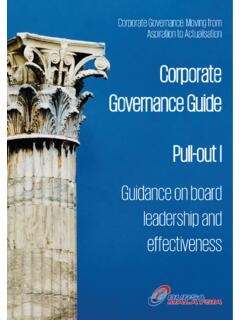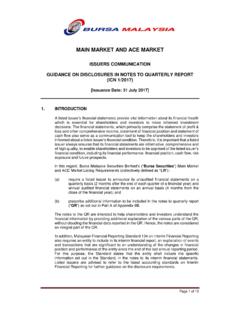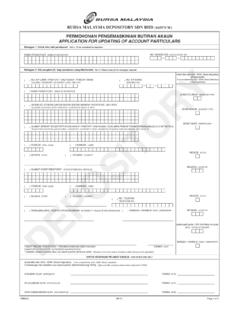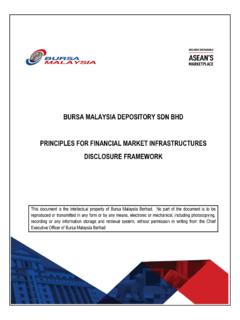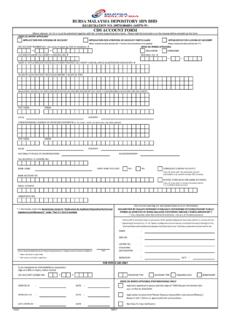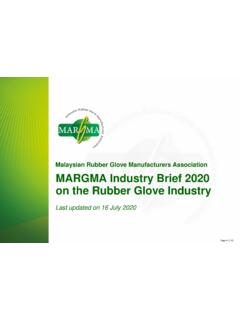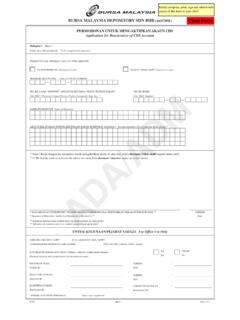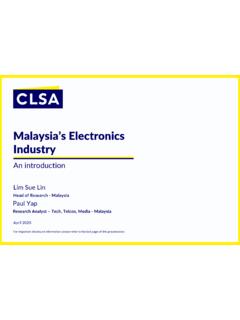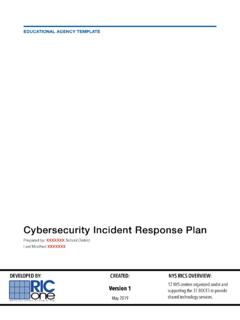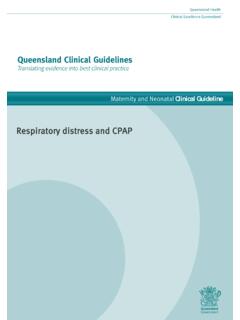Transcription of Corporate Governance Guide - Bursa Malaysia
1 Corporate Governance : Moving from Aspiration to Actualisation Pull-out II Guidance on effective audit and risk management Corporate Governance Guide Corporate Governance Guide Pull-out II Contents Introduction 1 Background 1 Section I : Establishment and effectiveness of the audit committee 2 Section II : Roles and responsibilities of the audit committee 6 Section III: Communication on audit, risk management and control 13 Practices and Step Ups 15 Effective audit Practice 16 Practices and 20 Step Up 31 Practice 37 Risk management and internal control framework Practices and 44 Step Up 60 Practices and 65 Appendices 75 Appendix I : Questions to be posed to management financial reporting 76 Appendix II : External auditor evaluation form 82 Appendix III : Matters to be tabled to the audit committee on related party 89 transactions Appendix IV : Financial literacy questionnaire 90 Appendix V.
2 Controls and compliance Questions to be posed to senior 92 management Appendix VI : Examples of risk indicators 98 Appendix VII: Evaluation of internal audit function 99 Corporate Governance Guide Pull-out II 1 Introduction Background This Introduction to Pull-out II ( Effective audit and risk management ) is designed to provide companies with broad guidance in making suitable arrangements for their audit and risk management processes as well as to assist directors serving on audit committees in carrying out their role. The Overview also intends to provide companies with direction in implementing the relevant enumerations of Principle B in the Malaysian Code on Corporate Governance and thus, should be read in conjunction with the write-ups on the individual Practices and Step Ups encapsulated in this Pull-out.
3 In today s complex and evolving business environment, an effective audit and risk management process can make a strong contribution to a no surprises environment. Being vigilant of uncertainties requires companies to anticipate future challenges, understand what is on the horizon, and address risk more strategically all of which calls for greater oversight, accountability and transparency. In this regard, a robust audit committee can be a key feature of a strong Corporate Governance culture underpinned by effective audit and risk management. In discharging its mandate, it is imperative for audit committees to be supported by fundamental building blocks, namely an appropriate structure and foundation, well-defined responsibilities, an understanding of current and emerging issues as well as a proactive, risk-based approach to its work.
4 An audit committee s relationship with the board, management and internal and external auditors plays a pivotal role in driving its effectiveness. The essential features of these interactions are a frank, open working relationship and a high level of mutual respect. The audit committee must be prepared to take a robust stance, and all parties must be prepared to make information freely available to the committee, to listen to their views and to deliberate on the issues candidly. Every company needs to consider in detail what audit and risk management arrangements are best suited for its particular circumstances as what work bests for one company may not necessarily be ideal for another.
5 These arrangements need to be proportionate to the task, and will vary according to the size, maturity, complexity and risk profile of the company. Nevertheless, there are certain guiding principles and practices which underlie the effectiveness of an audit and risk management process and they can help to ensure that company-specific approaches are applied effectively that is, by the right people with the right information, procedures and perspectives. This Introduction is set out over three sections. Section I addresses the establishment and effectiveness of the audit committee. Section II explores the audit committee s responsibilities in overseeing the areas of financial reporting, related party transactions and conflicts of interests, internal control environment, internal audit and external audit.
6 Section III meanwhile sheds light on the communication of audit, risk management and internal control matters. Corporate Governance Guide Pull-out II 2 Establishment and effectiveness of the audit committee Establishment and terms of reference Given the importance of an audit committee to the Governance structure of a company, the establishment of this committee is mandated for listed issuers by Paragraph of Bursa s Listing Requirements. The need for a charter or written terms of reference and minimum functions of the audit committee (covered in Section II of this Overview) is meanwhile set out in Paragraphs and of Bursa s Listing Requirements.
7 Similar provisions are also encapsulated for financial institutions in Bank Negara Malaysia s Policy Document on Corporate Governance1. The audit committee charter must be approved and adopted by the board and it must set out in sufficient detail the specific duties, responsibilities and authority of the audit committee. Such terms of reference will not only help committee members focus on their roles but the disclosure of such will also enable stakeholders to be apprised of their responsibilities. Once established, the charter should be assessed, reviewed and updated at least annually by the committee or as and when there are changes to the regulatory requirements and changes to the direction or strategies of the company that may affect the audit committee s role.
8 The committee should recommend any changes to its terms of reference to the board for the latter s approval. The assessment of the committee s terms of reference should be a rigorous process, taking into consideration the company s circumstances and any new regulations that may have an effect on the audit committee s responsibilities. Composition and membership Appointments to the audit committee should be made by the board on the recommendation of the nominating committee, in consultation with the audit committee chairman. In determining the composition and membership of the audit, the board should take into account factors such as size, independence and desired skills and qualities of the members.
9 1 Standard and Appendix I of Bank Negara Malaysia s Policy Document on Corporate Governance . Section I Independence As stated in Paragraph (1)(b) of Bursa s Listing Requirements, the audit committee should comprise non-executive directors with a majority being independent. Paragraph of the Listing Requirements also prescribes that the chairman of the audit committee must be an independent director. Considerations on independence are covered in detail in the write-ups to Practice and Step Up Size The size of the audit committee will vary depending on the needs of the company, the board and the extent of responsibilities delegated.
10 Paragraph (1)(a) of the Listing Requirements mandates listed issuers to appoint an audit committee comprising no fewer than three members. Skills and qualities An appropriate level of expertise, experience and commitment amongst members is essential to the fulfilment of the committee s mandate. At least one member of the audit committee must fulfil the financial expertise requisite of Paragraph of Bursa s Listing Requirements. Considerations on financial literacy and other pertinent qualities are covered in detail in the write-up to Practice Corporate Governance Guide Pull-out II 3 Meetings It is for the audit committee chairman, in consultation with the company secretary, to decide the frequency and timing of its meetings.
